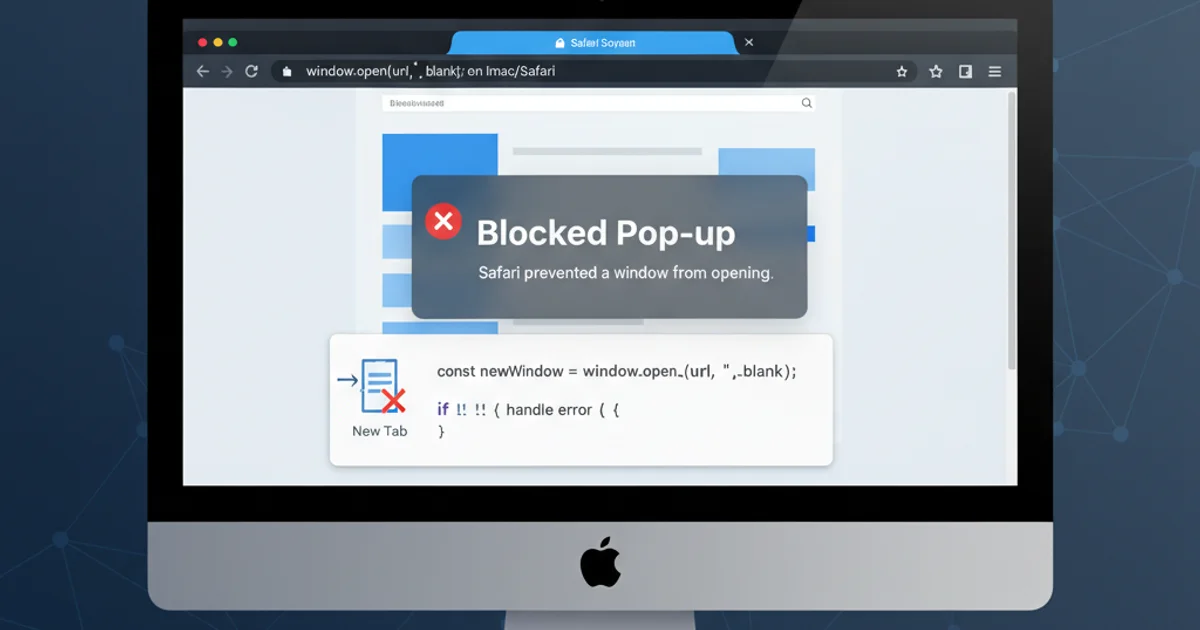window.open(url, '_blank'); not working on iMac/Safari
Categories:
Troubleshooting window.open() Issues on Safari/macOS

Learn why window.open(url, '_blank'); might not work as expected on Safari, especially on macOS, and discover robust solutions to ensure new tabs or windows open reliably.
The window.open() method is a fundamental part of web development for opening new browser windows or tabs. However, developers often encounter issues, particularly when targeting the _blank attribute on Safari, especially on macOS. This behavior is usually tied to Safari's stringent pop-up blocking policies and how it interprets user interaction. Understanding these nuances is key to implementing reliable new window functionality across all browsers.
Understanding Safari's Pop-up Blocker
Safari, like many modern browsers, has a robust pop-up blocker designed to enhance user experience by preventing unwanted advertisements and malicious content. The core principle behind these blockers is to only allow window.open() calls that are directly initiated by a user action, such as a click event. If window.open() is called outside of a direct, synchronous user event handler, Safari is highly likely to block it, treating it as an unsolicited pop-up.
flowchart TD
A[User Clicks Button] --> B{Is window.open() called synchronously within click handler?}
B -- Yes --> C[window.open() succeeds]
B -- No --> D[Safari Pop-up Blocker Activated]
D --> E[window.open() fails/is ignored]
C --> F[New Tab/Window Opens]
E --> G[No New Tab/Window]Safari's Pop-up Blocker Logic for window.open()
Common Scenarios and Solutions
The most frequent reason window.open() fails is when it's decoupled from a direct user interaction. This can happen due to asynchronous operations, setTimeout, or complex event handling. The primary solution is to ensure the call is made directly within the event handler.
// This will likely be blocked by Safari
document.getElementById('myButton').addEventListener('click', () => {
setTimeout(() => {
window.open('https://example.com', '_blank');
}, 100);
});
// This is the correct way to ensure it works
document.getElementById('myButton').addEventListener('click', () => {
window.open('https://example.com', '_blank');
});
Synchronous vs. Asynchronous window.open() calls
window.open() is called synchronously, some ad blockers or browser extensions might still interfere. Always test your implementation across various browsers and with common extensions enabled.Handling Asynchronous Operations Gracefully
Sometimes, you need to perform an asynchronous operation (like an API call) before opening a new window. In such cases, you cannot directly call window.open() after the async operation completes, as it will be blocked. A common workaround is to open the window immediately with a placeholder URL and then update its location once the asynchronous data is ready.
document.getElementById('asyncButton').addEventListener('click', async () => {
// Open a blank window immediately
const newWindow = window.open('', '_blank');
if (newWindow) {
try {
// Simulate an asynchronous operation (e.g., API call)
const response = await fetch('https://api.example.com/data');
const data = await response.json();
const targetUrl = `https://example.com/details?id=${data.id}`;
// Update the new window's location
newWindow.location.href = targetUrl;
} catch (error) {
console.error('Failed to fetch data:', error);
// Close the blank window if an error occurs
newWindow.close();
alert('Could not open the page. Please try again.');
}
} else {
alert('Pop-up blocked! Please allow pop-ups for this site.');
}
});
Opening a window with a placeholder and updating its URL after an async operation.
newWindow object might be null (if the pop-up was still blocked) or if the asynchronous operation fails. Always provide user feedback.1. Verify Direct User Interaction
Ensure your window.open() call is directly nested within a user-initiated event handler (e.g., click, submit). Avoid wrapping it in setTimeout, setInterval, or Promise.then() if possible.
2. Implement Placeholder Window for Async Operations
If asynchronous data is required, open a blank window (window.open('', '_blank')) immediately upon user interaction. Then, update its location.href once your data is ready. Remember to check if the newWindow object is valid.
3. Provide Fallback or User Guidance
If window.open() returns null (indicating a blocked pop-up), inform the user that pop-ups need to be enabled for your site. You might also offer an alternative, like opening the link in the current tab or providing a direct link to click.
4. Test Across Browsers and Devices
Always test your implementation on various browsers (Safari, Chrome, Firefox, Edge) and operating systems (macOS, Windows, iOS, Android) to catch browser-specific quirks and ensure consistent behavior.